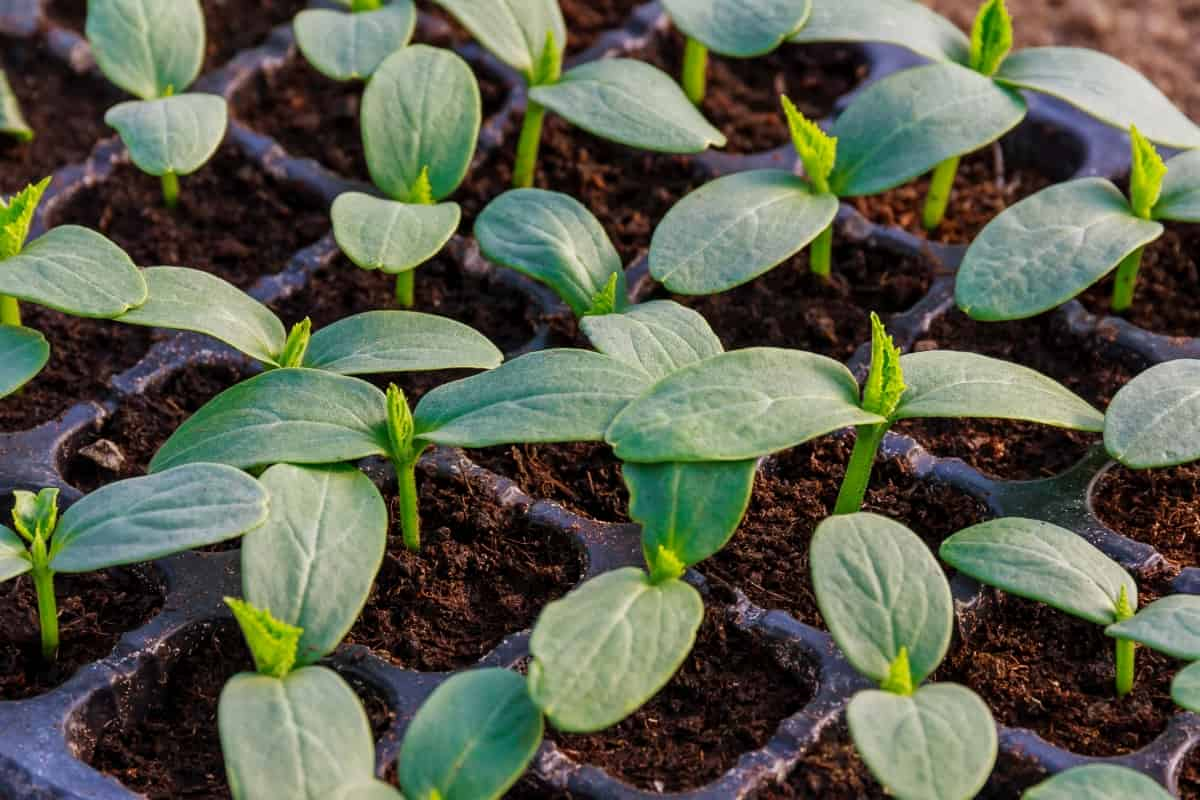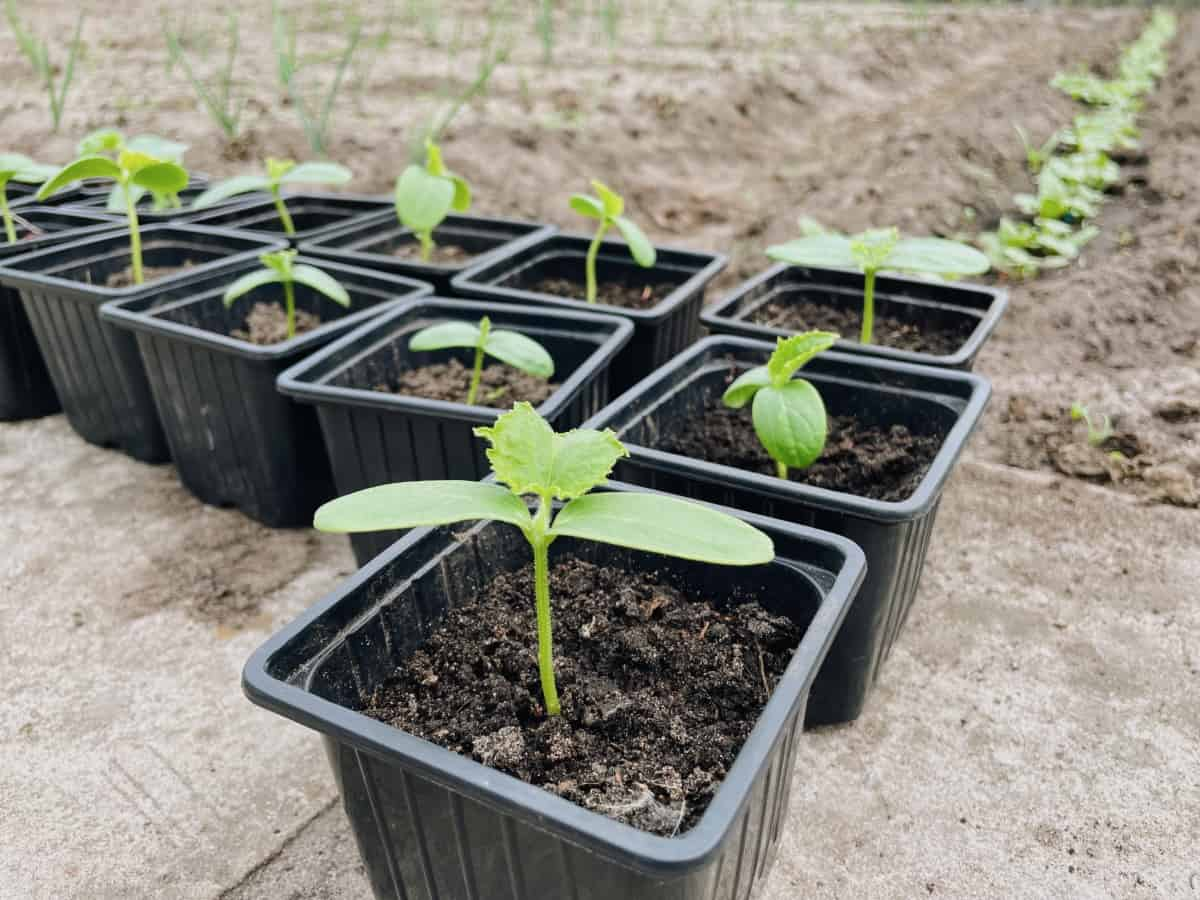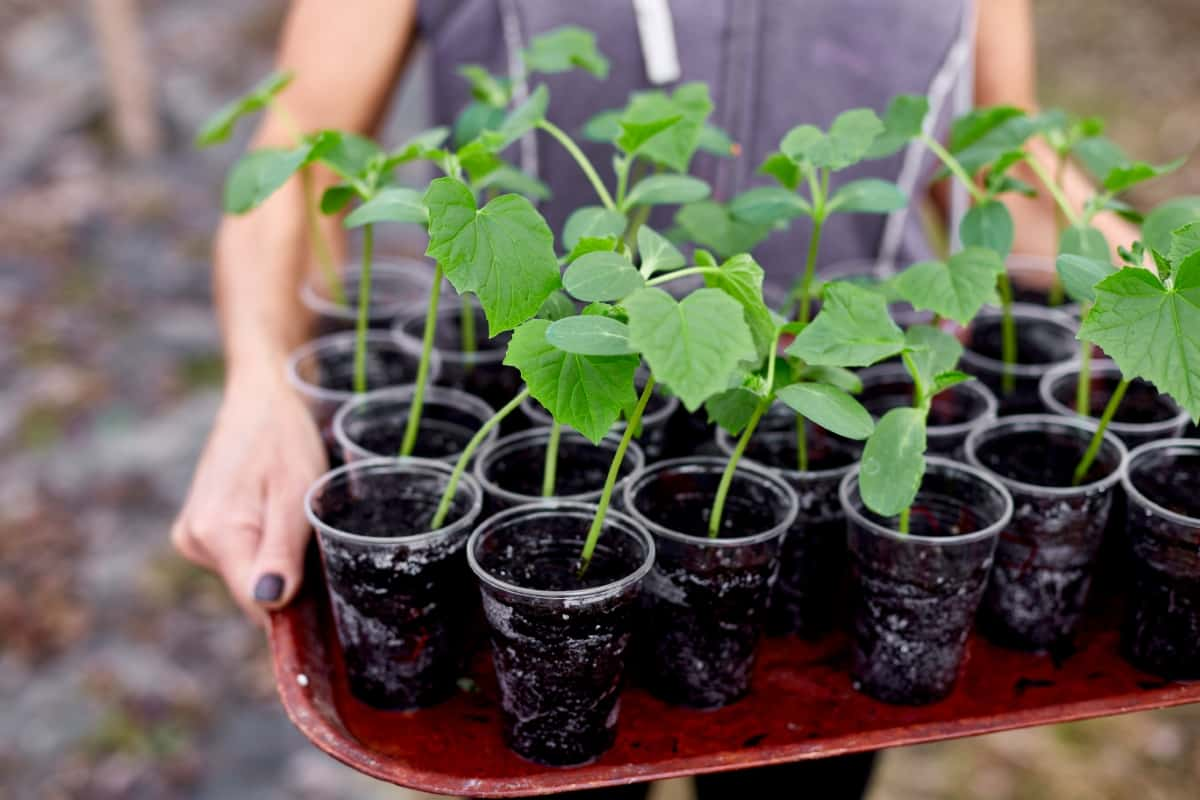Transplanting Cucumber seedlings is a key step in ensuring a successful harvest. But before diving into the process, it’s essential to understand the basics. Transplanting means moving young Cucumber plants from their initial container or seed tray to a larger pot or directly into the garden soil. This allows them to continue growing and thriving in their new environment.
Timing plays a vital role in transplanting Cucumbers. You want to wait until all chances of frost have passed and the soil temperature has warmed up sufficiently for optimal growth. Too early, and your delicate seedlings could suffer from cold damage; too late, and they may struggle with establishing strong roots.
The Best Time for Transplanting to Ensure Growth Success
Ideally, you should wait until all frost danger has passed before transplanting your Cucumber seedlings outdoors. When it comes to the best time to transplant cucumbers, these are warm-weather crops that thrive in temperatures between 21°C – 35°C. In most regions, this means transplanting Cucumbers in late spring or early summer.

How to Transplant Cucumber Seedlings
Selecting Healthy Cucumber Seedlings
Criteria for Choosing the Best Seedlings for Transplant
Look for seedlings that have developed strong root systems. Healthy roots are essential for successful transplantation and future growth. Avoid seedlings with weak or damaged roots, as they may struggle to establish themselves in their new environment. Consider the overall appearance of the seedling. Look for plants that are sturdy and well-developed with vibrant green leaves. Avoid any signs of yellowing or wilting, as these can indicate underlying issues or poor health.
Preparing Seedlings for the Transition Outdoors
First, give your seedlings a few days to acclimate to outdoor conditions before transplanting them. Start by placing them outside in a sheltered area for a few hours each day, gradually increasing their time outside over several days. This process will help them adjust to changes in temperature and wind. Next, make sure your seedlings are well-hydrated before transplanting.
Preparing the Garden Bed
Soil Preparation Techniques for Optimal Growth
With the right cucumber transplanting strategies, you can create an environment that supports their development and ensures a bountiful harvest. When it comes to Preparing soil for cucumber transplant, choose a well-draining soil for your Cucumbers. They prefer moist but not waterlogged conditions. Before transplanting your seedlings, prepare the planting area by loosening the soil with a garden tiller. This will allow roots to penetrate easily and access necessary nutrients.
Amending Soil with Compost and Fertilizers
One key aspect of successful Cucumber transplanting care is preparing the soil to provide optimal nutrition for the seedlings. Amending the soil with compost and fertilizers is crucial to ensure healthy growth and abundant harvests. When it comes to Soil amendments for cucumber seedlings, Compost is a fantastic natural amendment that enriches the soil with organic matter. It improves soil structure, enhances moisture retention, and provides a steady release of nutrients.
Incorporating compost into your garden beds before transplanting will create a nutrient-rich environment for your Cucumber plants to thrive in. In addition to compost, using fertilizers can further boost plant growth by supplying necessary macronutrients like nitrogen, phosphorus, and potassium. However, it’s important not to overdo it – excessive fertilizer application can harm plants rather than benefit them.
Transplanting Techniques for Cucumber Seedlings
Step-By-Step Guide to Transplanting
Transplanting Cucumber seedlings can be a crucial step in ensuring their successful growth and maximum harvest. How to transplant cucumber plants? First, choose a suitable location for transplanting your seedlings. Cucumbers grows well in full sun and well-drained soil. Remove any weeds or debris and loosening it with a garden fork. Next, gently remove the seedlings from their containers. If the roots are tightly bound, carefully untangle them before planting.
Dig holes that are larger than the root ball of each seedling in the prepared soil. Place each seedling into its hole, making sure it is at the same depth as it was in its original container, and Spacing cucumber seedlings correctly. After planting all the seedlings, water them thoroughly to settle the soil around their roots. It’s important to keep them well-watered during this transplantation period to prevent stress and promote healthy growth.
How to Minimize Transplant Shock in Cucumber Seedlings
One essential step to minimize transplant shock is to handle the seedlings with care. When it comes to Avoiding transplant shock in cucumbers, gently loosen the soil around each plant and carefully lift them by holding onto their leaves or roots. Avoid touching the stems as they are delicate and prone to damage. Before transplanting, it’s crucial to prepare the planting holes adequately. Dig holes larger than the root ball of each seedling. This will give them enough space for growth while providing good contact with the surrounding soil.
In case you missed it: Guide to Growing Cucumbers in California: In Containers, Backyard, Summer, and Winter

Watering After Transplanting
Proper Watering Techniques for New Transplants
To ensure your newly transplanted Cucumber seedlings receive adequate moisture, it’s important to water them deeply but infrequently. This means giving them a thorough soak rather than light sprinkles every day. Watering cucumbers after transplanting encourages the development of strong roots that can better withstand drought conditions. One effective technique is to water the plants at their base rather than overhead. You can use a watering can or drip irrigation system for precision watering.
Establishing a Watering Schedule to Support Growth
When it comes to watering Cucumbers, consistency is key. These plants thrive in moist soil, so it’s important to keep the soil moist throughout their growing season. One effective method is deep watering. This involves providing a thorough soak once or twice a week rather than light daily watering. Deep watering encourages deeper root growth as the roots are encouraged to reach down into the soil for moisture.
Mulching to Support Transplanted Seedlings
Benefits of Mulching for Cucumber Plants
One effective technique to enhance the growth and productivity of Cucumber plants is mulching. Mulch offers a variety of benefits that can optimize the overall health of your Cucumber plants. Mulching helps conserve moisture by reducing evaporation from the soil surface. By creating a barrier between the soil and air, mulch prevents water loss, ensuring that your Cucumber plants stay hydrated for longer periods. This is particularly beneficial during hot summer months when water scarcity becomes an issue.
Choosing the Right Mulch for Cucumbers
When it comes to choosing the right mulch for your Cucumber plants, there are a few factors to consider. First and foremost, you want a mulch that will retain moisture in the soil and keep weeds at bay. Organic options such as straw or shredded leaves work well for this purpose. Straw is a popular choice because it allows air and water to penetrate easily while also providing insulation for the roots.
It helps maintain an even temperature around the plant, preventing fluctuations that can stress out Cucumbers. Shredded leaves are another great option as they break down slowly, releasing valuable nutrients into the soil. They also create a barrier against evaporation and weed growth.
Support Structures for Growing Cucumbers
Installing Trellises and Supports for Climbing Varieties
Installing trellises and supports for climbing varieties of Cucumbers is a crucial step in optimizing their growth and productivity. Choose the right type of trellis or support system that suits your garden space and Cucumber variety. There are various options available, such as bamboo stakes, wire mesh cages, A-frame structures, or even homemade trellises using strings or netting. Make sure they are sturdy enough to withstand the weight of the vines when fully grown.
Training Cucumber Vines for Maximum Production
One of the key factors in maximizing Cucumber production is proper vine training. By guiding the vines to grow in a controlled manner, you can ensure maximum exposure to sunlight and improve air circulation around the plants. This not only promotes better fruit development but also helps prevent disease. To train Cucumber vines, start by gently tying them to trellises or supports as they begin to grow.
As the vines continue to lengthen, regularly guide them along the support system, ensuring they stay on track and don’t become tangled or overcrowded. It’s important to note that different Cucumber varieties have varying growth habits. Some are bushy and compact, while others are climbers. For climbing varieties, such as English Cucumbers, or vining types like pickling Cucumbers, it’s crucial to provide sturdy trellising structures for support.
In case you missed it: Stages of Cucumber Plant Growth

Monitoring and Caring for Transplanted Seedlings
Identifying Signs of Stress and Addressing Issues
Gardeners must be able to identify signs of stress to address them promptly. One common sign of stress in Cucumber seedlings is wilting leaves. If you observe that the leaves are drooping or turning yellow, it could indicate a lack of water or nutrients. Another indicator of stress is stunted growth. If your Cucumber plants are not growing as vigorously as they should be, there may be underlying issues with soil fertility or inadequate sunlight exposure.
Pests and diseases can also cause significant stress for Cucumber plants. Keep an eye out for any unusual spots on the leaves, discoloration, or evidence of pests such as aphids or spider mites. To address these issues effectively, it’s important to take immediate action. Adjust watering schedules if necessary and ensure that your Cucumbers receive adequate sunlight throughout the day. Implement pest control measures like organic insecticides or natural predators like ladybugs.
Routine Checks for Pests and Diseases
Inspect your Cucumber plants on a regular basis. Look for pest infestations like holes in the leaves, chewed edges, or discolored spots. If you spot any suspicious activity or signs of disease, act immediately to prevent further damage. There are various organic methods you can use to control pests and diseases, such as handpicking insects off the plants or spraying a solution made from neem oil.
Fertilizing Cucumber Plants After Transplant
Fertilizer Types and Application Schedules for Cucumbers
Organic fertilizers are excellent choices as they provide essential nutrients while improving soil structure. These organic options release nutrients slowly over time, ensuring a steady supply for your Cucumbers throughout the growing season. If you prefer synthetic fertilizers, look for a balanced formula with nitrogen, phosphorus, and potassium. This balanced approach promotes overall plant health and encourages vigorous growth.
Remember to follow the manufacturer’s instructions carefully when applying synthetic fertilizers to avoid overfeeding your Cucumbers. As for application schedules, it’s best to divide the fertilizer into multiple applications throughout the growing season. Start by applying a slow-release organic fertilizer at planting time to provide a steady source of nutrients in the early stages.
Organic vs. Synthetic Fertilizers for Cucumber Plants
Organic fertilizers are made from compost, manure, or bone meal. They provide slow-release nutrients that gradually feed the plants over time. This can result in healthier soil structure and improved long-term plant growth. Additionally, organic fertilizers are often more environmentally friendly and sustainable.
Synthetic fertilizers are chemically manufactured to provide specific nutrients to plants. They offer quick results and can be easily tailored to meet specific nutrient deficiencies in the soil. Synthetic fertilizers also tend to be less expensive than their organic counterparts.
In case you missed it: Best Fertilizers for Cucumber: Homemade, Organic, Liquid, NPK, and Schedule

Conclusion
Follow the Cucumber seedling transplant tips for successful transplantation, taking care not to damage the delicate roots of the seedlings. Once transplanted, provide proper care and maintenance by watering regularly, providing support as needed, and protecting against pests or diseases. With patience, diligence, and some tender loving care, successful cucumber transplanting strategies you’ll soon be rewarded with an abundance of fresh Cucumbers that are perfect for salads, pickling, or enjoying straight from the vine.
- How to Grow Hibiscus from Flower
- Plantation Ideas for Home Decoration: A Beginners Guide
- Flower Garden Designs and Layouts for Beginners
- Planting and Spacing Techniques in Papaya: A Beginner’s Guide
- Growing Gold: Essential Techniques for Planting Pineapples
- How to Make Kalanchoe Plant Bushy: Home Remedies and Solutions
- 11 Reasons Why Your Gardenia is Not Blooming: Home Remedies and Solutions
- Eco Elegance: The Guide to Designing a Drought-Tolerant Landscape
- Gardening on a Slope: Strategies for Hillside Landscaping